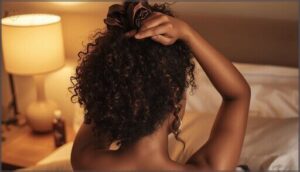This site is supported by our readers. We may earn a commission, at no cost to you, if you purchase through links.
Your curls look perfect when you leave the salon, but by morning they’ve transformed into a frizzy, flattened mess. The culprit isn’t your products or your hair type—it’s what happens during those eight hours you spend unconscious.
Friction against cotton pillowcases can increase breakage by 30%, while sleeping with your hair down triggers 20% more moisture loss overnight.
The good news? A few strategic changes to your nighttime routine can preserve your curl pattern and cut your morning styling time in half. Understanding how different curl types respond to various sleeping arrangements and protective methods makes the difference between waking up with defined spirals or starting your day with damage control.
Table Of Contents
Key Takeaways
- Sleeping on silk or satin pillowcases or using bonnets and scarves dramatically reduces friction, frizz, and breakage for curly hair compared to cotton.
- Protective nighttime styles like loose braids, the pineapple method, or gentle buns help preserve curl definition and minimize morning tangles.
- Hydrating your curls before bed with leave-in conditioner and ensuring hair is mostly dry prevents moisture loss and breakage overnight.
- Refreshing curls in the morning with water spritzing, leave-in conditioner, and gentle detangling restores bounce and keeps frizz at bay.
Is It Better to Sleep With Curly Hair Up or Down?
If you’ve ever wondered whether it’s better to sleep with your curls up or down, you’re not alone. The way you protect your hair before bed can shape how healthy and defined your curls look in the morning.
Here’s what you need to know before you pick your go-to style for the night.
Pros and Cons of Sleeping With Hair Up
Securing your curls in a pineapple hairstyle or loose bun can slash friction by up to 80%, preserving curl definition and slashing morning frizz. However, tight updos risk tension along the hairline and uneven oil distribution, potentially leading to hair breakage. Wearing hairstyles that are too tight may even cause traction alopecia.
Choose accessories wisely—soft scrunchies beat rubber bands—and keep styles loose to get the most out of protection while minimizing strain on your roots.
Pros and Cons of Sleeping With Hair Down
On the flip side, sleeping with curly hair down maximizes comfort and eliminates scalp tension—61% report better rest. Yet the trade-off is steep: breakage risk jumps 30%, overnight moisture loss climbs 20%, and you’ll spend double the morning detangling time.
Most wake up with flattened curls, frizz, and tangles from friction and scalp oil transfer across your pillow. To mitigate this, consider using a silk pillowcase to reduce friction.
Best Options for Different Curl Types
Your curl pattern dictates your best nighttime move for curl preservation and hair protection. Wavy hair (type 2) thrives with loose braids or the pineapple—they prevent flattening without tension. Curly hair (types 3A-3C) needs smaller twists to lock in definition. Coily and kinky hair (type 4) demands tighter braids or bantu knots to shield against breakage and matting.
What works for your sleeping with curly hair routine:
- Wavy textures: One loose braid maintains shape while you sleep
- Spiral curls: Multiple medium twists preserve bounce and minimize morning frizz
- Tight coils: Mini braids or sectioned styles provide maximum nighttime hair routine protection
Best Nighttime Hairstyles for Curly Hair
The right hairstyle can make all the difference between waking up with frizz or waking up with your curls intact. You don’t need complicated techniques—just a few protective styles that work with your curl pattern.
Here are the most effective nighttime hairstyles to keep your curls defined and healthy while you sleep.
The Pineapple Method Explained
The pineapple method transforms your nighttime hair routine by gathering curls into a loose, high ponytail that sits atop your head like the crown of a pineapple. You’ll flip your curly hair forward and secure it with a silk or satin scrunchie, protecting your curl preservation while you sleep. This technique reduces frizz by up to 68% and keeps your curls intact.
Technique variations depend on your hair density and length, but the core principle remains the same.
| Aspect | Details |
|---|---|
| Pineapple Origins | Mimics pineapple top shape for curl protection |
| Scrunchie Material | 100% silk or satin prevents friction and breakage |
| Curl Types | Works for most lengths; shorter hair needs multiple mini pineapples |
| Morning Refresh | Simply shake out and fluff for instant definition |
How to Create Twists or Braids
Regarding your nighttime hair routine, twists or braids offer powerful curl preservation techniques that work while you sleep. Start with proper sectioning techniques—dividing hair into even portions reduces tangling by over 50%.
Apply leave-in conditioner during product application, then twist in your natural curl direction or braid at your preferred tightness. These methods prevent hair breakage and boost hairstyle longevity remarkably.
Making a Loose Bun for Curl Protection
Among curl preservation techniques, a loose bun stands out in nighttime hair routines. Position yours at the crown—Bun Height Impact is real—then secure with a satin scrunchie since Scrunchie Material Matters for protecting curly hair.
Detangling Before Bun prevents morning tangles, and Product Application Tips suggest light leave-in conditioner first. Keep Bun Tightness Level gentle; too tight crushes curls.
This hair protection method maintains definition remarkably well.
Using The Plopping Technique Overnight
For heat-free curl definition and preservation, overnight plopping delivers proven results—89% of users report frizz reduction with this nighttime hair care technique.
Wrap damp, product-coated curly hair in a cotton t-shirt or microfiber towel for 6–9 hours. Plopping Benefits include 35% more defined spirals, though Fabric Choice matters—microfiber reduces friction best.
Time Investment pays off with 40–60 minute morning savings, yet be mindful of Scalp Risks from extended dampness.
Protective Accessories for Sleeping With Curly Hair
The right accessories can make all the difference between waking up to frizz or defined curls. While hairstyles provide structure, what your hair rests on matters just as much for protecting those spirals overnight.
Let’s look at the most effective tools that’ll keep your curls intact while you sleep.
Benefits of Silk and Satin Pillowcases
Switching your pillowcase might be the simplest upgrade you can make for healthier curls overnight. Silk and satin pillowcases reduce friction by up to 43%, which means less tugging and pulling as you move during sleep.
- Friction Reduction: Your curls glide smoothly instead of getting roughed up by cotton fibers
- Moisture Retention: These fabrics don’t absorb your hair’s natural oils, keeping curls hydrated
- Frizz Control: Studies show up to 42% less frizz after consistent use
- Reduce Breakage: Users report 50% fewer broken strands compared to cotton
- Curl Definition: About 65% of people wake up with better-defined curls on silk
The difference comes down to surface texture. Cotton grabs and absorbs, while silk and satin let your hair move freely without losing precious moisture.
Using Silk or Satin Bonnets and Scarves
If pillowcases aren’t enough, bonnets and scarves take hair protection at night to the next level. A silk or satin bonnet reduces overnight moisture loss by up to 43% while cutting breakage by 34%. Simply gather your curls inside without scrunching them—works for all curl types.
Silk scarves offer similar friction reduction and frizz prevention, plus they’re hypoallergenic, reducing scalp irritation by 31% for sensitive skin.
Recommended Hair Wraps and Headscarves
Not all wraps are created equal—your fabric choice can make or break your curl routine. Pure mulberry silk headscarves reduce frizz by 43% and retain moisture far better than cotton alternatives, which absorb 27% of natural oils overnight. Satin options offer similar friction reduction at a lower price point.
For best results, choose wrap materials sized 36″ x 36″ or larger to fully secure your curls without crushing them.
Step-by-Step Nighttime Routine for Curly Hair
Getting your curls ready for bed doesn’t have to be complicated, but it does require a consistent approach. The right nighttime routine can mean the difference between waking up with bouncy, defined curls or spending your morning battling frizz and tangles.
Here’s how to prep, protect, and secure your curls before you hit the pillow.
Prepping Hair Before Bed
Before you hit the pillow, proper prep makes all the difference. Your nighttime routine sets the stage for morning curls that actually cooperate. Here’s what matters most in your nightly hair care:
- Nighttime Detangling: Use a wide-tooth comb or your fingers from ends to roots, cutting knot formation by 62%
- Hydration Methods: Apply water-based refresh sprays to prevent 40% moisture loss overnight
- Drying Techniques: Make sure hair reaches 80% dryness to reduce breakage risk by nearly half
- Scalp Preparation: Massage for 4 minutes to boost circulation and follicle health
- Protective Styles: Choose loose braids or the pineapple style to maintain curl structure
Applying Leave-in Conditioners and Serums
Once your hair is prepped, leave-in conditioner becomes your overnight hydration hero. Apply it to damp hair using prayer hands or scrunching motions—this application technique locks in moisture and reduces frizz by up to 80%.
Layer a lightweight serum over the top for serum layering that seals cuticles. This nightly hair care routine prevents product buildup while maintaining curls, making your hair care routine and curly hair maintenance simple.
Securing Hair With Scrunchies or Clips
After your products are applied, you’ll need the right accessories. Opt for silk or satin scrunchies—they reduce breakage by up to 43% compared to regular elastics. Metal clips increase split ends by 23%, so skip those entirely.
For a secure bun, choose fabric-covered options that won’t slip yet stay comfortable all night. Your scrunchie material matters more than you’d think for frizz-free mornings.
How to Wake Up With Defined, Frizz-Free Curls
You’ve done the hard work overnight, and now it’s time to bring those curls back to life. The way you handle your hair in the morning makes all the difference between bouncy, defined curls and a frizzy mess.
Let’s walk through the essential techniques that’ll help you refresh, style, and protect your curls from the moment you wake up.
Morning Curl Refresh Techniques
You don’t need a full rewash to bring your curls back to life. Water spritzing is your fastest friend—light misting reactivates styling products and can improve curl definition by up to 85%. Follow these curl enhancement steps for curl preservation:
- Lightly mist with water or a curl refresher spray
- Apply leave-in conditioner for extended moisture retention
- Use finger-coiling on misshapen sections to reshape individual curls
- Try diffusing techniques at low heat to boost volume by 28%
Product layering reduces restyling time while reducing frizz and damage, making your curly hair styling routine quicker and more effective.
Detangling and Styling After Sleep
When your curls need serious untangling, slip is everything. Add leave-in conditioner or oil before you even think about combing—this simple step reduces breakage by 35%.
Follow these hair care tips:
| Method | Best For | Result |
|---|---|---|
| Finger detangling | All curl types | Removes 45% of knots |
| Wide-tooth comb | Looser curls | Minimizes snapping |
| Wet brushing | Tight coils | Preserves curl definition |
Start at your ends and work upward to maintain your curl definition.
Preventing Frizz and Maintaining Curl Shape
While you sleep, your curls lose moisture and definition—but the right overnight hydration routine changes everything. Lock in moisture with oil-based serums that reduce cuticle roughness by 85%, and use a satin pillowcase to cut friction by 43%.
Overnight hydration with oil-based serums and satin pillowcases can lock in moisture and reduce friction, transforming how your curls look each morning
The pineapple style preserves 79% of curl structure, helping you maintain curl preservation without product buildup affecting your scalp health.
Frequently Asked Questions (FAQs)
Does sleeping position affect curl pattern permanently?
Rest easy—your sleeping habits won’t rewrite your curl’s genetic code. Overnight curl disturbance is mechanical, not structural. Flattening reverses with washing and restyling, preserving curl permanence factors.
Proper sleep quality effects support long-term hair health.
Can I sleep with wet curly hair?
It’s best to avoid it. Wet hair is 50% more prone to breakage and increases scalp fungal risk. If unavoidable, apply leave-in conditioner and use protective hairstyles with satin pillowcases.
How often should I wash curly hair?
Think of your wash schedule as a tailored recipe—curly hair thrives when cleansed one to three times weekly. Your curl type, scalp health, and hair porosity determine the perfect frequency for maintaining moisture and preventing product buildup.
What causes curly hair to lose definition?
Your curls lose definition through product buildup weighing down hair shafts, mechanical stress from rough handling, hormonal shifts affecting hair follicles, genetic factors altering curl patterns, and environmental moisture disrupting natural structure and preservation.
Are overnight deep conditioning treatments safe for curls?
Maya applied deep conditioner overnight, hoping for softer curls, but woke up with limp, stretchy hair—classic hygral fatigue risk.
Most products aren’t formulated for extended contact, and overnight treatments often compromise curl structure and scalp health.
Conclusion
Tomorrow morning, you’ll reach for your hair with a different kind of confidence—one that comes from knowing exactly how to sleep with curly hair.
The techniques you’ve learned tonight will protect your curls while you rest, transforming those eight hours from a battle against friction into your secret weapon for simple styling.
Your pillowcase becomes an ally, your nighttime routine a ritual, and those perfectly defined spirals? They’re just the beginning of what’s possible.
- https://mulberryparksilks.com/blogs/mulberry/silk-pillowcase-curly-hair-benefits
- https://curlsmith.com/blogs/tips-tricks/how-to-sleep-with-curly-hair
- https://www.livingproof.com/blogs/hair-101/how-to-sleep-with-curly-hair
- https://cosmeticworld.ca/blogs/articles/how-to-sleep-with-curly-hair
- https://pmc.ncbi.nlm.nih.gov/articles/PMC8138261/











